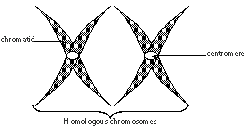
Cell Reproduction
Somatic cells: body cells.
Human somatic cells contain 46 chromosomes (23 pair)
Gametes: sex cells used in sexual reproduction.
Chromosomes
Chromatid: 2 joined strands; each is a duplicate of its partner
Centromere: point where chromatids are held together; also attaches chromosome to the microtubules of the spindle fiber
Homologous chromosomes: chromosomes that contain the same kind of information but come from different parents.

Cell Reproduction
Mitosis: The type of cell division in which the major event is nuclear division.
Occurs in eukaryotes.
Necessary for growth, healing wounds, repairing injured body parts.
Cytokinesis: cytoplasmic division that follows nuclear division
Interphase: period of cell growth, DNA synthesis, and preparation for cell division.
non-reproducing stage in which a cell spends most of its lifephase in which a cell prepares itself for cell division
begins when cell reproduction is completed
duplicates genetic material; so at the end each cell has two sets
assembles structures and organelles
G1 Phase: cell growth phase.
S Phase: DNA replicates.
G2 Phase: preparation for mitosis. Cell organelles duplicated, cell increases in size.
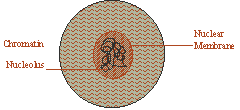
Prophase
First phase of mitosis.Chromatin begins to coil into chromosomes, becoming visible.
The nuclear membrane begins to dissolve.
In animal cells, 2 pairs of centrioles separate and move to opposite poles of the cell.
Microtubules form in between the centrioles and become spindle fibers.
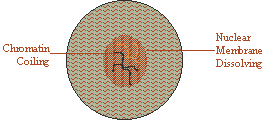
Metaphase
second stage of mitosis
chromosomes become attached to the spindle
chromosomes line up along the equator of the cell
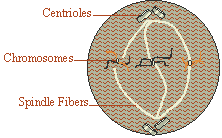
Anaphase
third stage of mitosis
paired chromatids are pulled apart at the centromere and move to opposite poles of the cell
as anaphase ends, there is one set of single-stranded chromosomes at each end of the cell
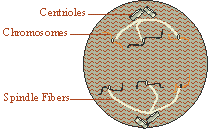
Telophase: chromosomes begin to uncoil, nuclear membrane begins to reform.
fourth and last stage of mitosis
two cells begin to form from one
nuclear membrane reforms and encloses chromosomes
nucleoli reappears
chromosomes lose distinct outline and appear as a mass of chromatin
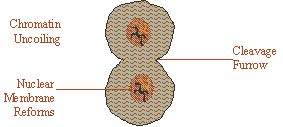
Cytokinesis
Division of the cytoplasm.
Animal cells form a cleavage furrow.Plant cells form a cell plate.
2 new daughter cells are formed.
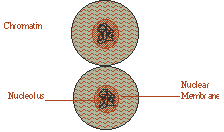
Most cells complete mitosis in one to two hours.
Approximately 25 million cell divisions occur every second in the adult human body.
Cancer is a rapid, uncontrolled division of one kind of cell that invades and disrupts cells in other tissues.